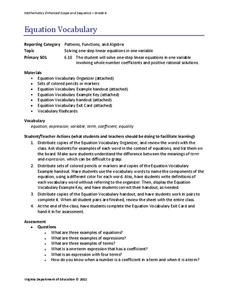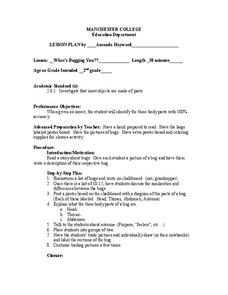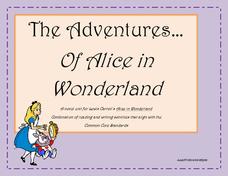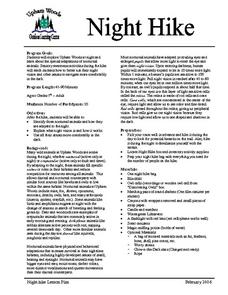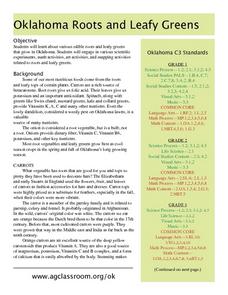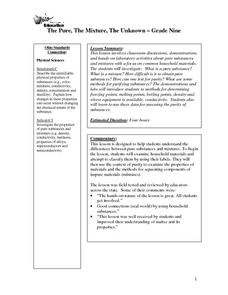Curated OER
Know your roots!
Looking at an image of plant systems with their roots in the ground, learners determine which would be the most or least difficult to pull. They write short sentences describing which plant they chose and why. Intended for 3rd or 4th...
Virginia Department of Education
Equation Vocabulary
You'd feel bad if someone called you by the wrong name — and equations are no different. Young mathematicians learn the vocabulary associated with equations and expressions identifying these components in sample equations.
Curated OER
One Of A Kind
Young scholars explore current fashion trends. As a class, they discuss the statements that a dress makes, brand names, and cultural trends. Fashions from other cultures are observed and discussed by students. In pairs, young scholars...
Curated OER
Exploring Equal Parts
In this math worksheet, students examine 3 sets of shapes. In each set, there is one figure that has been divided evenly and one that has not. Students color the shape that shows an equal division.
Curated OER
The Geologists' Dilemma
Students search in groups of five for colored beads that have been scattered over the classroom. They will search for one of our energy resources represented by one color bead to determine that resources are limited.
Curated OER
Pattern Using Unit Cells
Young scholars explore the pattern of the unit cell. In this science lesson, students color the unit cells on a worksheet and create a pattern using unit cells.
Curated OER
Launching Rockets
Second graders discuss experiences of watching a rocket launch either on television or in person before making paper rockets. They make and color rockets which they attempt to launch using a strong breath blown through a straw at the...
Curated OER
Preying on Beans
Students act as predators searching for prey (beans) in two different settings to demonstrate the processes of adaptation and selection.
Curated OER
The Amazing Octopus
Students design imaginary animals that are able to blend into their backgrounds. In this biology lesson plan, students will learn the importance of camouflage in protecting animals from predators. Students will select a peer to act as...
Curated OER
What's Bugging You?
Second graders investigate insects. For this parts of a whole, 2nd graders discuss what the three body parts of an insect are as well as the antenna. Students create their own insect labeling each body part and antenna.
Curated OER
Seeing Cells
Sixth graders study living cells and their functioning units. In this cell lesson plan students color cell diagrams, answer questions and discuss the differences between plant and animal cells.
Curated OER
Anansi Goes Fishing: Compound Words
This PowerPoint gives the definition and examples of compound words. The students then identify the two words contained within in each of several illustrated compound words. Although the font and its color provide appropriate and clear...
Orange Or Apple
Flashcards Deluxe
A useful study tool, learners create decks or download pre-made decks to review. The app tracks your progress and allows you to customize your experience with each deck. Why not try it out and test yourself and your pupils on thousands...
Berkshire Museum
Adopt a Schoolyard Tree
Help young scientists connect with nature and learn about trees with a fun life science lesson. Heading out into the school yard, children choose a tree to adopt, taking measurements, writing descriptions, and drawing sketches of it in...
Stillwater Central School District
The Adventures… Of Alice in Wonderland
Go down the rabbit hole with a thorough novel unit for Lewis Carroll's Alice in Wonderland. With a cause and effect chart, K-W-L organizer, and reading comprehension questions, the resource is a great addition to your summer...
Curated OER
Weekly Reading Test
In this word recognition worksheet, 1st graders write 10 site words that the teacher calls out. Students must also write two words three times each.
Curated OER
Patterns
Second graders create an ABAB pattern with their name. In this early elementary math instructional activity, 2nd graders first model their names in an ABAB pattern with unifix cubes. They then recreate the pattern using letter stamps on...
Curated OER
The Acetate Animal Hunt
Students determine which adaptations allow an organism to survive and reproduce in a certain environment. Students act as "predators" to pick up acetate discs "prey" scattered around the classroom. Students list the number found, the...
Curated OER
The Big Bang Theory
Young scholars explore the Big Bang Theory and discover how it can be used to explain the origin of the universe. For this Big Bang Theory lesson, students use a balloon with colored paper inside, blow it up and pop it, group the colored...
Curated OER
Visual Models of Solutions and Concentrations
Students model solutions with beakers of colored glass or plastic spheres. For this solutions lesson, students use beakers of colored spheres to represent pure substances. They mix the spheres to demosntrate solutions. They discuss...
Curated OER
Night Hike
Students explore Upham Woods at night and investigate about the special adaptations of nocturnal animals. They identify three nocturnal animals and how they are adapted to the night. Students explain what night vision is and how it works.
Curated OER
The Beet Goes On
Root vegetables inspire the series of activities included here. Class members participate in activities related to language arts, social studies, science, visual art, and math. At first, the long list might feel overwhelming; however,...
Curated OER
The Pure, The Mixture, The Unknown
Ninth graders participate in classroom discussions, demonstrations and hands-on laboratory activities about pure substances and mixtures with a focus on common household materials. They investigate: What is a pure substance? What is a...
Curated OER
Mapping Seamounts in the Gulf of Alaska
Students describe major topographic features on the Patton Seamount, and interpret two-dimensional topographic data. They create three-dimensional models of landforms from two-dimensional topographic data.



